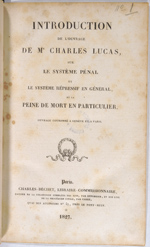Building Cornell University Library’s Collections
Criminal Justice and Prison Reform
Should the penal system exist primarily to punish or to reform? Or are prisons merely a means to keep criminals where they can do no harm to others? Should inmates live in groups, or in isolation? Should juvenile offenders be treated differently from adults? Is capital punishment moral?
With funds provided by Cornell’s Class of 1956 Rare Book Endowment Fund, the Division of Rare and Manuscript Collections has established a collection on the history of crime and prison reform in Europe, Britain, and America, encouraging students and scholars to explore these and related questions from a historical perspective.
In 2003 Cornell University Library acquired the working library of Charles-Jean-Marie Lucas (1803-1889), a nineteenth-century authority on French prison reform whose ideas continue to influence Western penal systems today. The Lucas collection contains hundreds of books and pamphlets, including more than 100 titles written by the prolific reformer over a period of sixty-five years. Joining the Lucas collection is a group of more than 100 books on the history of crime and punishment in England, acquired in 2005. These collections build upon Andrew Dickson White’s own interest in eighteenth- and nineteenth-century reform movements. Many of the library’s existing books on the subject of prison reform bear White’s bookplate.
Cornell’s growing body of research materials on these subjects provide an essential resource for the study of criminal punishment, rehabilitation, capital punishment, and human rights, informing ongoing debates that continue to confront societies today.
Purchased with funds from the Class of 1956 Rare Book Endowment
 |
Charles Lucas. Introduction de L’ouvrage de Me Charles Lucas sur système pénal et du système répressif en général: et la peine de mort en particulier. Paris, 1827. [zoom] | View other images: 1 Lucas wrote more than 100 books on the subject of crime and punishment. His ideas on the treatment of prisoners include many still in use today, such as prescribed prison uniforms, rehabilitation through religious training, and justifiable death penalties for those deemed to be beyond redemption. From the Library of Charles Lucas |
 |
John Howard. “A Plan for a County Gaol.” and “Employments of Criminals” In The State of the Prisons in England and Wales, with...an Account of Some Foreign Prisons and Hospitals. Warrington: Printed by W. Eyres, and sold by T. Cadell and N. Conant, 1777. [zoom] | View other images: 1 John Howard set out to expose the unsanitary and barbarous conditions common in eighteenth-century English prisons. His book on the state of prisons in England and Wales, first published in 1777, is arguably the most important work on the subject in English. His book exposed a corrupt and unjust system and paved the way for generations of reformers who followed in his wake. Gift of Benno Loewy, ’19 |
 |
Society for the Improvement of Prison Discipline and for the Reformation of Juvenile Offenders. Description d’un moulin de discipline, appelé tread mill: inventé en Angleterre, par M. Cubitt. Londres: Publié par ordre du Comit´; De l’Imprimerie de T. Bensley..., 1822. [zoom] | View other images: 1 The prison treadmill was invented in England in 1817 by Sir William Cubitt, a noted civil engineer. The aim of the prison treadmill was to generate power for mills, though frequently it was used for no purpose other than to punish inmates. Widely employed in English prisons in the nineteenth century, the practice was abandoned by the early twentieth century as too cruel. From the Library of Charles Lucas |
| View a photo of this exhibition case | |